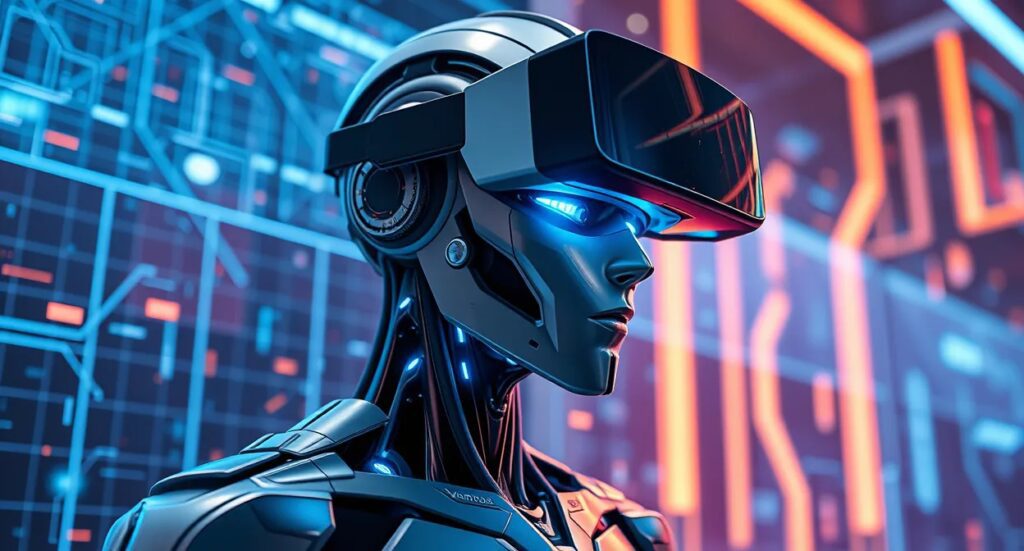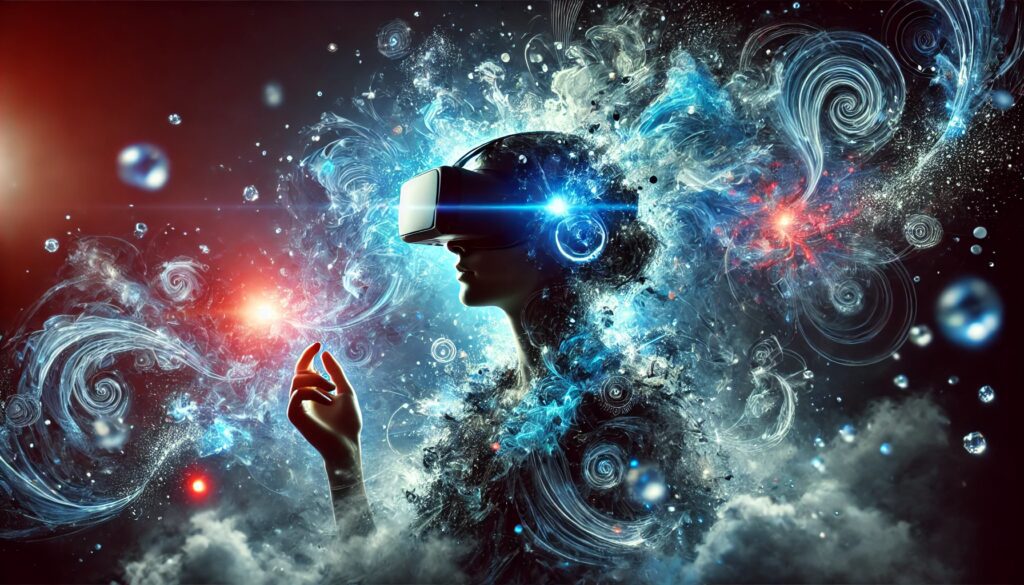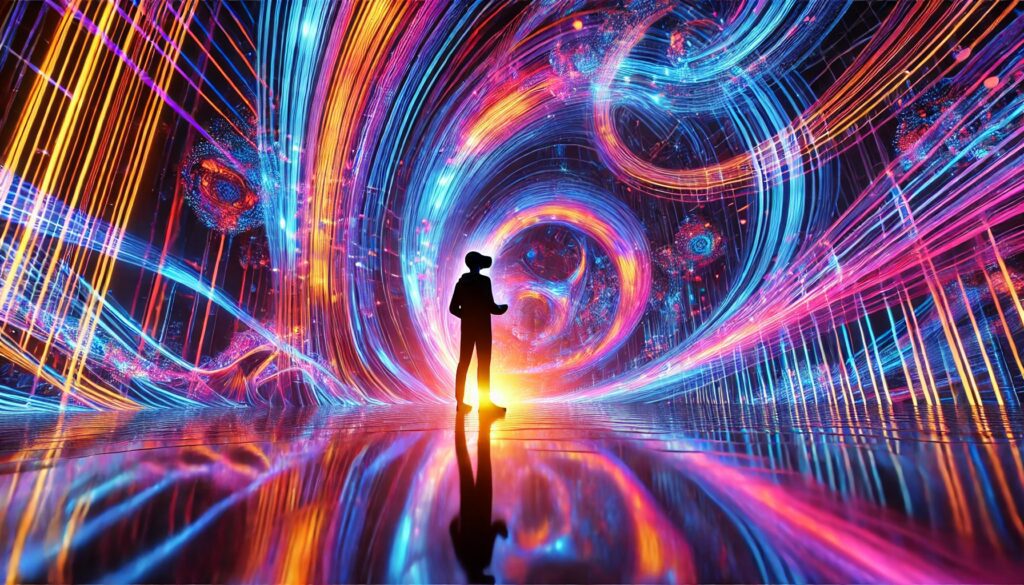
Virtual reality (VR) has revolutionized how we experience digital worlds, but neural rendering takes it to an entirely new dimension. By leveraging advanced AI techniques, neural rendering is enhancing the realism, interactivity, and immersion of VR environments.
Here’s how this groundbreaking technology is reshaping the virtual landscape.
What Is Neural Rendering and Why Does It Matter?
A Fresh Perspective on Rendering
Traditional rendering involves pre-programmed rules to simulate how light interacts with objects. Neural rendering flips the script by using neural networks to generate scenes, offering more dynamic and lifelike visuals.
This method adapts in real-time, making VR worlds feel genuinely alive. Whether it’s the subtle shift of light at sunset or intricate textures, the results are astonishing.
AI as the Driving Force
At the core of neural rendering lies machine learning. Algorithms analyze vast datasets of images to understand textures, shadows, and even motion. These insights allow VR to recreate scenes with unparalleled accuracy.
Realism That Feels Real: Neural Rendering’s Visual Impact
Recreating Life-like Textures
Ever notice how older VR games sometimes feel… flat? Neural rendering refines textures so they mimic real-world materials. Wood grains, metallic sheens, and fabric folds respond to lighting realistically.
It’s a massive leap in bridging the gap between digital and physical environments.
Real-Time Adjustments
Neural rendering adjusts visuals on the fly, a feature particularly crucial in VR. Dynamic shadows shift with your movement, and reflections update seamlessly as you explore environments.
Immersion Through Adaptive Interactions

Smarter Environmental Responses
Neural rendering allows virtual objects to behave just like real ones. For example, a ball will roll differently on grass than on a marble floor—thanks to the AI’s predictive modeling.
This level of interactivity makes VR experiences feel more authentic.
Enhanced Avatars
Human-like avatars are a cornerstone of many VR applications. Neural rendering enables realistic facial expressions and gestures, making avatars a lot more relatable.
Powering Neural Rendering: Tools and Techniques
GPUs Meet Neural Networks
Modern GPUs work hand-in-hand with neural networks to process complex computations. Technologies like NVIDIA’s Neural Graphics SDK are paving the way for these advancements.
Real-time Ray Tracing
Combining neural rendering with real-time ray tracing results in hyper-realistic lighting effects. This synergy elevates VR visuals far beyond traditional capabilities.
The Future of VR with Neural Rendering
Gaming Redefined
Imagine stepping into a VR game where every detail—down to the smallest leaf—is photorealistic. Neural rendering turns this into a reality, enhancing not only visuals but gameplay mechanics.
Beyond Gaming: Practical Uses
From virtual tourism to medical training, neural rendering’s impact extends beyond entertainment. Realistic simulations help professionals learn in immersive, risk-free environments.
Challenges in Adopting Neural Rendering
Computational Demands
Neural rendering is a powerhouse technology, but it’s resource-intensive. The need for high-performance GPUs and cloud computing infrastructure makes it challenging for widespread adoption.
Not every VR device can handle the processing requirements, potentially limiting accessibility for casual users.
Cost Barriers
Advanced hardware and software development aren’t cheap. For businesses and developers, the initial investment in AI-powered rendering tools can be steep.
This raises questions about affordability for smaller studios or individual creators looking to harness this cutting-edge tech.
Data and Privacy Concerns
Neural rendering relies on large datasets for training its algorithms. When VR applications collect user data to improve personalization, privacy concerns can arise, particularly in sensitive applications like healthcare.

Neural Rendering in VR: Current Real-World Applications
Revolutionizing Gaming
Games like Half-Life: Alyx already push VR visuals to incredible levels. Neural rendering could make environments so detailed and responsive they become indistinguishable from reality.
Think adaptive enemies or ecosystems where wildlife behaves naturally based on your actions.
Transforming Film and Entertainment
Virtual production in movies is booming, and neural rendering brings a new level of realism to CGI. Directors can now shoot scenes in immersive virtual spaces that react in real-time.
This approach has been used in productions like The Mandalorian to blend physical and digital environments seamlessly.
Advancing Virtual Social Spaces
Platforms like Meta Horizon Worlds could benefit from enhanced avatar realism. Neural rendering makes expressions, eye movements, and even micro-emotions more genuine, improving communication in virtual meetings.
Key Players Driving Neural Rendering Innovation
NVIDIA’s Pioneering Role
NVIDIA continues to lead the charge with tools like its Neural Graphics SDK. These technologies enable developers to integrate neural rendering into VR applications efficiently.
Their breakthroughs in DLSS (Deep Learning Super Sampling) highlight how neural networks can optimize rendering for both performance and quality.
Research Institutions on the Frontier
Academic institutions like MIT and Stanford are advancing neural rendering techniques. Their focus on AI training models ensures faster, more accurate rendering without massive computational demands.
These efforts drive innovation while tackling scalability issues.
Gaming Implications of Neural Rendering in Virtual Reality

Hyper-Realistic Environments
Neural rendering brings a jaw-dropping level of realism to gaming. Imagine stepping into a VR jungle where every blade of grass, droplet of water, or shimmer of sunlight reacts naturally to your presence.
With this technology, game environments feel alive. Trees sway dynamically with wind, shadows follow characters seamlessly, and even weather systems adjust in real time. This makes exploration more engaging and emotional.
Expanding Game Worlds
Developers can use neural rendering to generate expansive, procedurally rendered landscapes without sacrificing detail. Think of open-world games like Elden Ring or The Legend of Zelda: Breath of the Wild reimagined in VR, with richer textures and evolving ecosystems.
Smarter, More Immersive NPCs
Neural rendering doesn’t just enhance visuals—it adds depth to characters too. Non-playable characters (NPCs) can have realistic facial expressions, subtle body language, and even reactions that reflect their surroundings.
Real-Time Emotional Reactions
Picture a scenario where an NPC responds to your choices with expressions of fear, joy, or anger that are dynamically rendered in real time. This takes storytelling and player interaction to a level of immersion never before possible.
Predictive Behaviors
With AI-driven neural rendering, NPCs could anticipate and adapt to player actions. An enemy in a stealth game might analyze your movement patterns and adjust its patrol route intelligently.
Enhanced Gameplay Mechanics
Dynamic Interaction with Objects
Neural rendering creates objects with textures and physics that behave like their real-world counterparts. For example, a stone feels heavy when picked up, and its surface reflects light authentically.
This can influence puzzle-solving and combat. Imagine gripping a shield that responds to impacts realistically or a sword with subtle reflections hinting at hidden inscriptions.
Real-Time Feedback for Players
The technology can render visual and environmental cues that react to player actions instantly. A well-placed spell might create ripples in water or cause a wall to crack, giving immediate and visually stunning feedback.
Making Multiplayer More Immersive
Lifelike Avatars for Social VR
In multiplayer VR games, neural rendering enables avatars to display nuanced facial expressions and body language. This enhances social experiences, making interactions in VR feel as natural as face-to-face conversations.
Cooperative Environments
When players collaborate in virtual spaces, neural rendering ensures seamless synchronization. Shared environments become richer and more detailed, improving teamwork and strategy.
Challenges in Game Design
Striking a Balance with Hardware
While neural rendering enhances graphics, it requires substantial computing power. Developers must design scalable solutions to ensure games run smoothly across both high-end and mid-tier VR systems.
Content Generation Complexity
Designing for neural rendering introduces new challenges in content creation. Teams need to work closely with AI tools to create assets that integrate seamlessly into the neural-rendered environment.
Neural rendering in VR gaming isn’t just about prettier graphics—it’s a complete shift in how we experience interactive worlds.
How Indie Studios Can Leverage Neural Rendering

Lowering the Barriers to Entry
Neural rendering, while cutting-edge, is becoming more accessible thanks to evolving tools and platforms. Indie studios can adopt pre-trained AI models and open-source libraries to integrate neural rendering without building everything from scratch.
For example, tools like NVIDIA DLSS or Unreal Engine’s AI-based rendering features provide entry points. These resources allow smaller teams to compete with AAA studios by achieving near-photorealistic visuals.
Procedural Content Generation
Indie studios often face budget constraints when creating large, detailed game worlds. Neural rendering can automate this process, generating expansive landscapes or realistic textures dynamically, saving both time and resources.
Imagine a small team producing a VR RPG with detailed forests and realistic villages, rivaling the visuals of major productions.
Enhancing Storytelling and Creativity
Neural rendering lets indie developers craft deeply immersive narratives. Realistic facial animations and body language can elevate emotional storytelling. This opens the door to unique, character-driven VR experiences.
Niche Markets and Unique Concepts
Indie studios often excel at exploring niche genres or experimental gameplay. Neural rendering can help them push boundaries. For example:
- A mystery game where subtle visual cues, like shifting shadows or reflective surfaces, hint at hidden secrets.
- A surreal exploration game where neural rendering adapts the environment based on the player’s emotions or actions.
Accessibility for Indie Developers
Cloud-Based Solutions
Cloud platforms like Google Cloud AI or AWS Machine Learning allow developers to access the power of neural rendering without needing costly hardware. This makes cutting-edge visuals achievable for studios with smaller budgets.
Crowdsourcing and Collaboration
Communities like GitHub and game development forums enable sharing of neural rendering assets and tools. Indie studios can leverage collective knowledge and resources to create polished VR experiences.
Neural Rendering’s Impact on Esports
Enhanced Spectator Experience
Esports thrives on engaging audiences, and neural rendering can take viewing experiences to the next level. Hyper-realistic environments make games more visually appealing to viewers.
Dynamic Replays
Imagine neural-rendered replays that add cinematic effects to gameplay. Real-time lighting changes, motion blur, and enhanced textures can make replays feel like action-packed movie scenes.
Personalized Viewing
AI-powered neural rendering could allow viewers to customize their perspective. For example, spectating a match from a player’s point of view with ultra-realistic environments rendered specifically for the audience.
Revolutionizing Competitive VR
Training with Realism
For competitive players, neural rendering enhances practice sessions by making environments feel as realistic as possible. This can improve reaction times and situational awareness, providing a competitive edge.
Interactive Live Matches
Neural rendering enables interactive features like live map adjustments or environmental hazards that evolve dynamically during matches. These mechanics make esports events more thrilling for participants and viewers alike.
Leveling the Playing Field
Democratizing Technology
As neural rendering becomes more widespread, even smaller esports titles could incorporate AAA-level graphics. This levels the playing field, giving lesser-known games a chance to shine in the competitive space.
Diverse Genres
Neural rendering could expand esports beyond traditional genres. VR simulation games or even virtual strategy tournaments could gain traction with this tech, making esports more inclusive and varied.
Tools for Indie Studios to Harness Neural Rendering

Open-Source Libraries and Frameworks
TensorFlow and PyTorch
Indie developers can use TensorFlow or PyTorch, two leading frameworks for training and deploying neural networks. These platforms are highly flexible, allowing developers to create custom rendering solutions or adapt existing ones.
By leveraging pre-trained models, developers can skip resource-heavy training and focus on fine-tuning their visual elements.
Unity and Unreal Engine Integration
Both Unity and Unreal Engine offer support for neural rendering features:
- Unreal Engine: Epic’s MetaHuman Creator lets developers design realistic characters with neural rendering-powered animations.
- Unity: Features like Perception AI allow dynamic asset generation and real-time rendering adjustments.
These engines simplify the process for small teams by combining neural rendering capabilities with robust development tools.
Cloud-Based AI Solutions
Google Cloud AI and AWS Machine Learning
Cloud platforms offer affordable, scalable options for indie studios that lack high-end hardware. For example:
- Google Cloud AI: Offers powerful image generation APIs for creating realistic textures or environments.
- AWS Machine Learning: Provides access to neural networks for rendering optimization and real-time scene adjustments.
Using cloud-based services, developers can generate complex, photorealistic assets without needing powerful in-house GPUs.
NVIDIA Omniverse
NVIDIA Omniverse is a collaborative 3D simulation platform that integrates neural rendering tools. It’s especially beneficial for small teams working remotely, as it enables real-time collaboration on highly detailed VR worlds.
Procedural Content Creation Tools
GANs (Generative Adversarial Networks)
Indie studios can utilize GANs to generate procedural textures, landscapes, and even characters. Platforms like Runway ML allow developers to experiment with GANs without needing advanced technical expertise.
Quixel Megascans
Although not specifically neural-rendering-focused, Quixel Megascans offers photorealistic 3D assets that can integrate with neural rendering workflows. Indie developers can combine these assets with neural models to create lifelike worlds on a budget.
Potential VR Esports Genres Enabled by Neural Rendering
Hyper-Realistic VR Sports
Imagine a VR soccer or basketball game where the court, players, and even the ball exhibit real-world physics and visuals. Neural rendering can make these environments indistinguishable from real-life, attracting traditional sports fans to VR esports.
Real-Time Physics Simulation
The technology enables dynamic ball movement, realistic player animations, and even weather effects for outdoor sports games. Players could train in conditions that adapt to their strategies or match scenarios.
Tactical Strategy Games
Neural rendering can bring strategy-based esports to life by creating immersive battlefields with highly detailed terrain. Games like VR StarCraft or Total War could incorporate:
- Environments that respond to player actions (e.g., burning forests, crumbling buildings).
- AI-rendered visual feedback for troop health or morale, adding layers of strategy.
This realism makes matches more engaging for players and spectators.
Immersive Battle Royales
The battle royale genre, a current esports favorite, can be reimagined in VR with neural rendering:
- Adaptive Landscapes: Environments change dynamically as matches progress, forcing players to adapt to shifting terrain or weather.
- Enhanced Survival Elements: Realistic survival mechanics, like accurate fire behavior or water physics, add depth to gameplay.
This level of immersion could draw casual and competitive players alike into VR-based battle royales.
Realistic Simulation Competitions
Driving and Flying Simulators
Simulators like VR Gran Turismo or flight training games could become esports staples. Neural rendering enhances vehicle mechanics, cockpit visuals, and external environments, creating a hyper-realistic competitive arena.
Construction and Problem-Solving Games
Imagine a VR esport where teams compete to design and build structures within a time limit. Neural rendering could simulate real-world material properties, offering unique challenges and rewards.
Story-Driven Competitive Games
Narrative-driven games don’t typically dominate esports, but neural rendering could change that. Imagine a game where players compete to navigate a detailed story, making choices that influence the outcome in real time. Spectators could follow along in immersive, hyper-realistic environments.
Overcoming Challenges in VR Esports with Neural Rendering
Ensuring Smooth Performance
Esports thrive on precision and responsiveness. Developers must ensure neural-rendered VR games maintain high frame rates to prevent motion sickness and input lag during competitive play.
Solutions:
- Hybrid rendering techniques that balance neural and traditional methods.
- AI optimization tools like NVIDIA DLSS to enhance visuals without sacrificing performance.
Accessibility for Players and Viewers
For VR esports to grow, neural rendering must be paired with affordable hardware solutions. Cloud gaming services like GeForce NOW or Shadow could bridge this gap, streaming high-quality rendered games to less powerful devices.
FAQs
Can neural rendering work on all VR devices?
Not all VR devices currently support neural rendering due to its high computational demands. Advanced systems like Meta Quest 3 or PC-tethered headsets with powerful GPUs are better equipped.
Cloud gaming services like GeForce NOW are bridging the gap, enabling lower-end devices to access neural-rendered content by offloading the heavy lifting to remote servers.
How does neural rendering improve VR gaming?
It enhances realism and interactivity. For instance:
- Environment Interaction: Water ripples when a player’s avatar walks through it.
- Dynamic NPCs: Enemies adapt their behavior to reflect player strategy in real-time.
These details make VR worlds feel immersive and engaging, keeping players emotionally invested.
Are there any games currently using neural rendering?
Yes, although the technology is still emerging. For example:
- Minecraft RTX: Uses AI-powered ray tracing to improve lighting and texture detail.
- Half-Life: Alyx: While not entirely neural-rendered, it incorporates advanced rendering techniques that showcase similar benefits.
Upcoming games are expected to adopt neural rendering fully, especially in the open-world and narrative-driven genres.
Is neural rendering accessible for indie developers?
Yes, though with limitations. Tools like Unreal Engine’s MetaHuman Creator and cloud-based AI platforms allow indie teams to leverage neural rendering without massive resources.
For example, an indie studio could use GANs to procedurally generate hyper-realistic textures for a VR escape room, creating an immersive experience on a tight budget.
What are the challenges of using neural rendering?
The primary challenges include:
- Performance Issues: Real-time rendering demands powerful hardware, which can lead to frame rate drops.
- Development Costs: Training and implementing AI models require expertise and resources.
However, hybrid techniques, cloud computing, and optimization tools like NVIDIA DLSS are making it easier to overcome these hurdles.
How does neural rendering impact competitive VR gaming?
It transforms gameplay and viewer experiences. For players, neural rendering ensures realistic feedback—for example, footprints in snow that affect stealth mechanics.
For spectators, it enables personalized views and cinematic replays. Imagine watching a competitive match in a virtual stadium, with rendered graphics adapting to your chosen perspective.
Does neural rendering have applications beyond gaming?
Absolutely. Neural rendering is being used in fields like:
- Medical Training: Realistic simulations for surgeries.
- Virtual Tourism: Immersive experiences of iconic locations.
- Architecture: Accurate visualizations of structures before construction.
For instance, a virtual house tour could render changing sunlight throughout the day, giving clients a complete sense of the space.
Is neural rendering limited to visuals?
No, it’s expanding into other areas like audio rendering and physics simulations. For example:
- Audio Rendering: AI-driven soundscapes adapt based on player location or actions, such as footsteps echoing differently in a cave versus a forest.
- Physics Simulations: Objects react in highly realistic ways, like a tree bending under the weight of snow or collapsing dynamically during a storm.
These enhancements make VR experiences feel even more lifelike and immersive.
Can neural rendering personalize VR experiences?
Yes, personalization is one of its most exciting potentials. Neural networks can adapt environments to individual users in real-time. For example:
- In a fitness VR app, weather and terrain could adjust based on a user’s preferences or physical performance.
- In a virtual museum, AI could render exhibits based on the visitor’s interests, ensuring a unique experience for each person.
This adaptability deepens engagement and satisfaction.
How does neural rendering impact game performance?
Neural rendering can strain hardware if not optimized. However, it also offers solutions like AI-based upscaling, which reduces resource usage while maintaining visual fidelity.
For example, NVIDIA’s DLSS (Deep Learning Super Sampling) allows high-resolution visuals to run smoothly on less powerful systems, ensuring better gameplay performance even with neural rendering.
Does neural rendering work in real-time?
Yes, neural rendering is designed to function in real-time, making it ideal for VR and AR applications. This means environments and elements update dynamically based on player actions or environmental changes.
For example, if a player shines a flashlight in a dark cave, neural rendering can instantly adjust shadows and reflections for realism.
Can neural rendering improve storytelling in games?
Absolutely. Neural rendering enhances storytelling by making characters and environments more expressive and responsive. For example:
- A character’s facial expressions can convey nuanced emotions like subtle sadness or joy during conversations.
- Environments can evolve with the story, such as a crumbling castle that deteriorates dynamically as the narrative unfolds.
This level of detail pulls players deeper into the narrative.
How does neural rendering affect motion in VR?
Neural rendering refines motion and animation, ensuring they appear smooth and natural. For example:
- In a VR dance game, a player’s movements can be mirrored with incredible accuracy, making their avatar’s gestures feel lifelike.
- In combat scenarios, enemies might move fluidly and adapt to the environment with realistic animations, enhancing challenge and immersion.
This improvement reduces the “uncanny valley” effect often present in less advanced animations.
How are neural rendering and ray tracing related?
Neural rendering often works alongside ray tracing to create highly realistic lighting and reflections. While ray tracing calculates how light behaves in a scene, neural rendering fills in details with AI-based predictions.
For example, instead of calculating every light ray for a reflective surface, neural rendering can approximate it with visually identical results but at a fraction of the cost.
What are some examples of procedural generation with neural rendering?
Neural rendering enhances procedural generation by creating high-quality, unique content on demand. Examples include:
- Dynamic Forests: In a survival game, forests could regenerate in unique patterns every time a player re-enters the area.
- Infinite Landscapes: Open-world VR games could use neural rendering to create vast, detailed terrains that change as players explore.
- Realistic Interiors: AI could design lifelike rooms with textures, lighting, and decorations tailored to a game’s setting.
This ensures variety and replayability without repetitive or predictable content.
Will neural rendering replace traditional rendering entirely?
Not in the near future. Neural rendering complements traditional methods, but full replacement requires overcoming challenges like hardware demands and AI training complexity.
A likely scenario is the rise of hybrid rendering techniques, where neural rendering handles dynamic elements like lighting or character animations, while traditional methods manage static elements to maintain performance.
Resources
Development Platforms and Tools
NVIDIA Omniverse
NVIDIA’s Omniverse is a cutting-edge platform for real-time 3D collaboration and simulation. It integrates neural rendering capabilities, making it a top choice for VR developers.
Unreal Engine
Epic Games’ Unreal Engine offers powerful tools for neural rendering integration, including MetaHuman Creator for lifelike characters.
Unity
Unity provides accessible solutions for smaller studios, with AI and machine-learning plugins to integrate neural rendering in VR projects.
Open-Source Libraries and Frameworks
TensorFlow
Google’s TensorFlow is a versatile framework for creating neural networks, widely used for neural rendering applications.
PyTorch
Developed by Facebook AI, PyTorch is known for its flexibility and ease of use in training rendering models.
GAN Applications
Generative Adversarial Networks (GANs) are critical for procedural asset creation. Tools like Runway ML simplify GAN integration for developers.
Cloud Computing Solutions
Google Cloud AI
Google Cloud offers scalable solutions for training and deploying neural rendering models without expensive hardware.
- Discover Google Cloud AI
AWS Machine Learning
Amazon’s AWS Machine Learning provides a suite of tools for AI-based rendering, making it accessible to developers of all sizes.
Microsoft Azure AI
Azure’s machine-learning tools streamline neural rendering workflows, particularly for enterprises and advanced VR projects.
Community and Collaboration Platforms
GitHub
GitHub hosts a wide range of open-source neural rendering projects and pre-trained models. Indie developers can collaborate and learn from existing repositories.
Stack Overflow
Join discussions and get answers to technical questions about neural rendering and VR integration.
Polycount
Polycount is a vibrant community of 3D artists and developers sharing insights and resources for creating high-quality visuals.
Online Courses and Tutorials
Coursera: AI for Everyone
This beginner-friendly course introduces AI concepts, helping you understand the fundamentals before diving into neural rendering.
Udemy: Game Development with Unreal Engine
A course covering Unreal Engine’s tools for creating realistic games, including rendering techniques.
NVIDIA Developer Program
NVIDIA offers tutorials and documentation for its tools, including DLSS and other neural rendering technologies.



